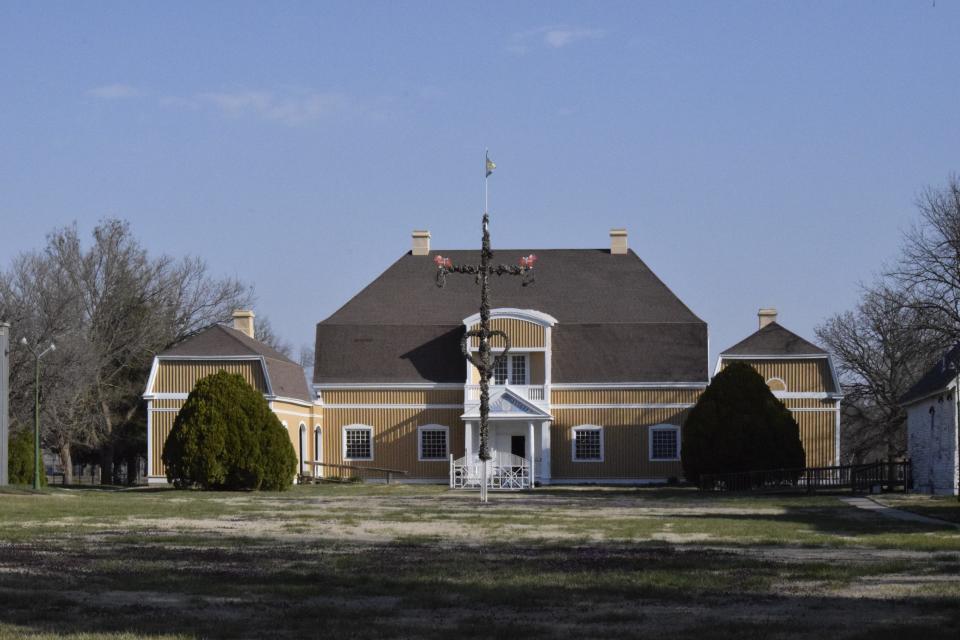Discovery of structural issue closes Lindsborg's Swedish Pavilion to the public
LINDSBORG — The Swedish Pavilion closed to the public as the Lindsborg Old Mill and Swedish Heritage Museum looks to make repairs to stabilize the building.
The pavilion, designed by Ferdinand Boberg and built for the 1904 World's Fair in St. Louis, was moved after the fair to Bethany College where it remained until 1969, when it was again moved to where it now sits opposite of the museum on Mill Street.
"In a lot of ways, it's remarkable that there's a structure to preserve," said Adam Pracht, marketing and communications director for the museum. "Those international buildings at the (1904) Fair, when they were building them, all of those structures, it was for the World's Fair. They were designed to last for about a year."
This building has withstood two different relocations and is still standing after 120 years.

Why did the Swedish Pavilion in Lindsborg need to close?
Pracht said a group of volunteers has helped to maintain some of the handiwork around the 15-acre museum, with at least one having a background in construction pointing out that the pavilion building was leaning a little bit.
The museum hired an engineering consultant who did a full structural evaluation and discovered it was leaning to the west, up to 2 degrees in some places.
"When you start looking at that over the height (of the building), it's basically a few inches every 6 feet," Pracht said.
Pracht said the engineers couldn't determine the exact cause of this lean, but have some ideas, many of which come from the fact that the building was disassembled partially and moved twice in its lifespan. When the engineer looked at historical documents and photos of it while it was being built in St. Louis, he noticed there are several cross-braces that are no longer seen in the internal structure.
"There's multiple things that could've happened (to those missing braces)," Pracht said. "There's a lot of story between St. Louis and here at the museum."
That history includes being deconstructed in St. Louis, shipped on a train to Bethany, where it was reconstructed and used as several different things on that campus before then being split in 1969 into three parts and moved to the museum on a flat-bed trailer.
"(The engineer) said it's ... been like this for decades, potentially," Pracht said.
Pracht said the engineer informed the museum that he couldn't predict when the pavilion would go from leaning to falling, but it's a building he would consider to be in structural failure.
"Given the wrong set of adverse weather conditions, primarily wind coming strong enough from a particular direction, it's a small chance — but a real chance — that it could collapse," Pracht said.
Even with this chance of failure being small, the museum and its board of directors decided they couldn't continue to have visitors inside the building unless the issue was resolved.
More: Status quo stipulation approved by city in Cozy Inn lawsuit
What will it take to get the Swedish Pavilion stabilized?
As a historic building, the museum wants to open back public access to the pavilion at some point, so it decided to go ahead with a stabilization repair plan, with the first phase getting started as soon as August.
According to Pracht, Phase 1 will permanently address the safety concern of the westward lean of the building.
"The northern most walls and southern most walls of the main building, the exterior portion will be removed, the cross-bracing will be installed ... then the exterior walls will be placed back," Pracht said.
According to Pracht, one notable piece of this repair is that it won't realign the structure back to zero degrees.
"Essentially, that (lean) will be frozen in place," Pracht said. "The reason they're not trying to correct it first and then freeze it into place is (that) could actually do more damage."
This plan for phase 1 has an estimated cost of $181,000, which the museum is working on procuring through a series of grant applications, including the Lindsborg David Nutt Large Grant, which the museum has received for previous projects.
It all goes to plan and repairs begin in August, Pracht said the pavilion could reopen to the public by the end of October. While this timeline means that several events that usually use the interior of the pavilion, like the annual Millfest and this year's Midsummer's Festival, will need to use space outside and the pavilion won't be open to the public.
With several events and festivals taking place throughout the year in Lindsborg, all is not lost for people looking to have a special time in the Swedish Pavilion in 2024.
"If that schedule goes well, and everything goes in our favor, it would mean that we could reopen before Heritage Christmas (on Dec. 14)," Pracht said. "That's pretty important, because all of our musical performances traditionally happen inside the pavilion, and the acoustics are something else."
This article originally appeared on Salina Journal: Lindsborg Swedish Pavilion walls closed to public after lean detected

